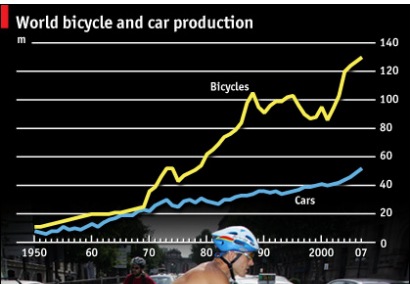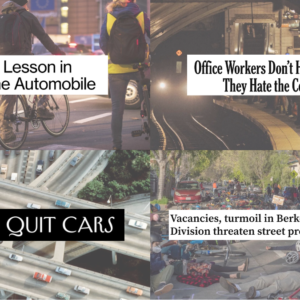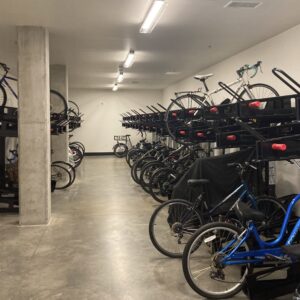The Economist published an interesting blurb and graphic on Monday.
They took a look at bicycle and car production since 1950 and found that,
“…Bicycle and car production grew pretty much in tandem in the two decades beginning in 1950. But since 1970 bike production has nearly quadrupled while car production has roughly doubled.”
They also noted that most of the increase has been in electric bikes, with production doubling since 2004, to 21 million units.
Here’s the graphic:

Check it out at Economist.com.
[Thanks to Paul H. and Spencer B. for the link.]





Thanks for reading.
BikePortland has served this community with independent community journalism since 2005. We rely on subscriptions from readers like you to survive. Your financial support is vital in keeping this valuable resource alive and well.
Please subscribe today to strengthen and expand our work.
Viva la bici!!
I’m assuming this is world wide?
Interesting stuff, especially when you consider how cars are being introduced into third-world countries..
Vive le velo electrique. Transportation without buckets of sweat or a huge carbon footprint
Assuming this is world wide would be correct, according to the title of the graph 😉
Still a lot of resource usage, not matter where the resources are going. I wonder what percentage of those bikes are the cheap throw-away type being sold at places like Walmart?
The peak in 1988 represents all those lovely lugged steel frames that are still rolling around Portland and every city in Europe. No planned obsolescence there. They last. Look at how bike production foundered in the nineties after reaching that height of reliability and utility. I doubt it is possible to read too much into this graph.
The data and analysis the Economist used for the graph comes from the Earth Policy Institute, here is the data from the horse’s mouth:
http://www.earth-policy.org/Indicators/Bike/2008.htm
Not to be a buzzkill, but couldn’t this just reflect an increasingly large middle class, who can afford to have recreational toys as well as basic transportation? And particularly, who can afford to buy bikes for their kids? It also helps that the cost of producing an inexpensive bike has plunged (you can order up a lot of mass-produced aluminum Chinese frames for a few dollars each), while the cost of producing cars is probably less volatile….
Not to be a buzzkill, but the numbers illuminate the fact that the world population is doubling every 30 years. We’re already destroying the planet now, what do you think Earths’s going to look like in 2038 when there’s 13 billion people?
makes sense…I have one car…and FOUR bikes… 🙂
one commenter pointed out that there was no data detailing the proportion of bike sales and manufacturing in China (or Vietnam, or Japan, &c) where the population density is very high and other factors make the bicycle the most popular choice.
I would also like to see that outlined for my own curiosity, because I have doubts that this is really any kind of indication of change in richer countries.
and I’m often a buzzkill so I’ll hold back my apologies. =)
“most of the increase has been in electric bikes”
Since western country populations have stabilized or even shrunk in the last 50 years, it would be a safe assumption that this growth is occuring elsewhere. I’ve spent a fair amount of time in 3rd world countries, in big cities where population density and expense pretty much rule out cars for the masses. In these places, I have noticed that your bike is an indicator and expression of your economic class, not unlike what kind of cell phone you have.
The poorest have pedal bikes, moving up to electric bikes, then gas powered scooters and then onto motorcycles for the well to do.
It would be interesting to see how gas powered scooters and small motorcycles would line up on this graph.
Zero cars, three bikes… can only ride one at a time though… 😉
My Mom has two bikes, one car… Now if I could only get her to lose the car…
Only tangentially related but Monday’s USA Today had an article about the manager of the Tampa Bay Devil Rays. He travels with his bike and does a lot of his strategic thinking while riding the bike.
Nice props for the bike from an unlikely source.
The online article does not have a picture but the hard copy did. http://www.usatoday.com/sports/baseball/al/rays/2008-09-22-rays-maddon_N.htm
“An avid rider, Maddon often cruises around major league cities trying to conjure ways for the Rays to win. This season it has worked, as he has managed Tampa Bay to its first winning season and playoff berth in its 11 seasons.
“It’s therapeutic,” Maddon says. “Managing definitely is a passion. But bike riding (is), too, if that makes any sense.”
Interesting – You can definetly see the bike boom of the 70’s and 80’s in the graph. In the 90’s, with the mountain bike boom, it just leveled off. I would imagine it falling or declining without the birth of the mountain bike.
The interesting part is the sharp rise since around 2001 in bike production. Could it be from the manufacturing boom in China? With the movement from farm workers to factory workers in China, they needed bikes to get to work. ???
It makes sense to me. The point about cars being uncommon in 3rd world countries aside, even in the US, most people HAVE a bike even if they don’t ride it much. And in a family of four, they will likely have 2 cars and at least 4 bikes. So as population increases it makes sense that there would be more bikes. But having a bike is not the same as riding it. Plus, all the people I know who ride bikes regularly have 3-10 bikes, whereas, car drivers generally have one car (plus a bike or two). Again, having a bike is not the same as riding it.
Yes, 66% of bicycles are made in China
http://www.earth-policy.org/Indicators/Bike/2008_data.htm#table3
I do wonder how many of them stay in China, (population 1.321B,) vs how many go other places. (There is apparently very few made in India, for instance, and while they don’t ride a much as the Chinese, they do ride some, and there are a lot of people in India, so they must be importing a lot from China.)
the first part of recycling is reduce…